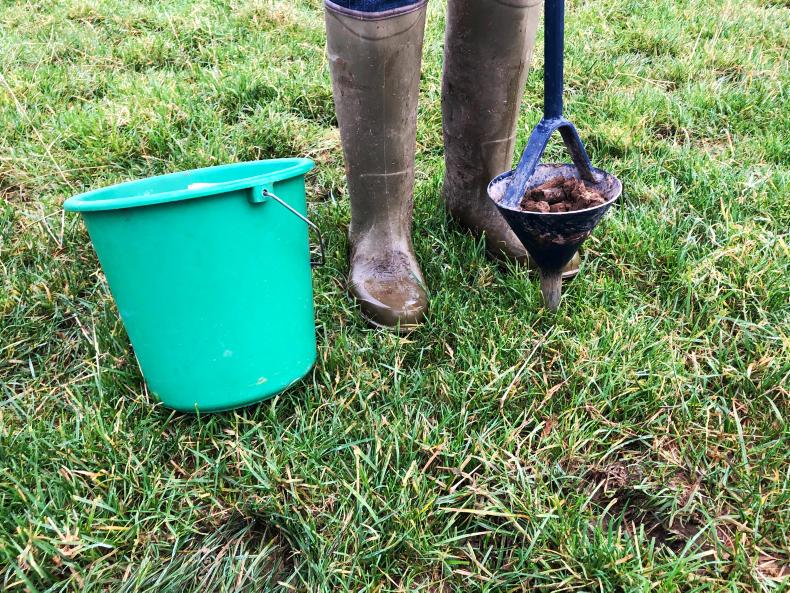Do you want to grow more grass next year? The answer should be yes and, if it is, soil fertility is the foundation required to do so.
The three key ingredients of soil fertility are phosphorous (P), potassium (K) and pH (lime).
You may wonder about nitrogen (N). Think of it this way: N is the fuel that powers grass growth during the growing season, but P, K and lime are the engine that drives the growth. No matter how much fuel you use, it won’t work without an engine.
Alarmingly though, only 10% of soils in Ireland are optimum for all three items. The only way for you to know what your soil situation is is to soil sample.
By soil sampling, a nutrient plan can be drawn up for your farm – including fertiliser, slurry and FYM - to correct nutrient deficiencies (if any).
Soil samples should be taken at least every five years and, on intensively stocked farms, they should be taken every two to three years. It is a mandatory task for farms in derogation.
Soil samples cost approximately €20 to €30/sample. A soil corer costs approximately €80.
How to
A standard soil sample will give the soil's pH, P, K and magnesium status.Soil tests should be taken as late as possible after the last application of lime, P or K to avoid skewing the test results.Do not sample for two years after a lime application and three months after P or K application.December and January are the best months to test.Nitrogen spreading does not affect soil sample results.Each soil test should represent between 2ha to 4ha of grassland.Use a soil corer and use it properly - P will build up in the top 2cm to 3cm of the soil, so it is important to take a core 8cm to 10cm in depth.Take samples in a fashion that give a fair reflection of the designated area – best practice is to walk in a W-shaped pattern across the field.Avoid any unusual spots such as drinking troughs, dung patches, waterlogged areas, etc.Take 20 to 25 cores per sample.Remember to ID each sample box and correctly correspond each sample ID with the designated area – it is best to write the ID on a map of the farm.Remember: the 0.5kg of soil you are sending off to be sampled will represent about 4,000t of soil (4ha x 10cm) – it is critical to have a proper soil sampling technique.
Do you want to grow more grass next year? The answer should be yes and, if it is, soil fertility is the foundation required to do so.
The three key ingredients of soil fertility are phosphorous (P), potassium (K) and pH (lime).
You may wonder about nitrogen (N). Think of it this way: N is the fuel that powers grass growth during the growing season, but P, K and lime are the engine that drives the growth. No matter how much fuel you use, it won’t work without an engine.
Alarmingly though, only 10% of soils in Ireland are optimum for all three items. The only way for you to know what your soil situation is is to soil sample.
By soil sampling, a nutrient plan can be drawn up for your farm – including fertiliser, slurry and FYM - to correct nutrient deficiencies (if any).
Soil samples should be taken at least every five years and, on intensively stocked farms, they should be taken every two to three years. It is a mandatory task for farms in derogation.
Soil samples cost approximately €20 to €30/sample. A soil corer costs approximately €80.
How to
A standard soil sample will give the soil's pH, P, K and magnesium status.Soil tests should be taken as late as possible after the last application of lime, P or K to avoid skewing the test results.Do not sample for two years after a lime application and three months after P or K application.December and January are the best months to test.Nitrogen spreading does not affect soil sample results.Each soil test should represent between 2ha to 4ha of grassland.Use a soil corer and use it properly - P will build up in the top 2cm to 3cm of the soil, so it is important to take a core 8cm to 10cm in depth.Take samples in a fashion that give a fair reflection of the designated area – best practice is to walk in a W-shaped pattern across the field.Avoid any unusual spots such as drinking troughs, dung patches, waterlogged areas, etc.Take 20 to 25 cores per sample.Remember to ID each sample box and correctly correspond each sample ID with the designated area – it is best to write the ID on a map of the farm.Remember: the 0.5kg of soil you are sending off to be sampled will represent about 4,000t of soil (4ha x 10cm) – it is critical to have a proper soil sampling technique.






 This is a subscriber-only article
This is a subscriber-only article










SHARING OPTIONS: